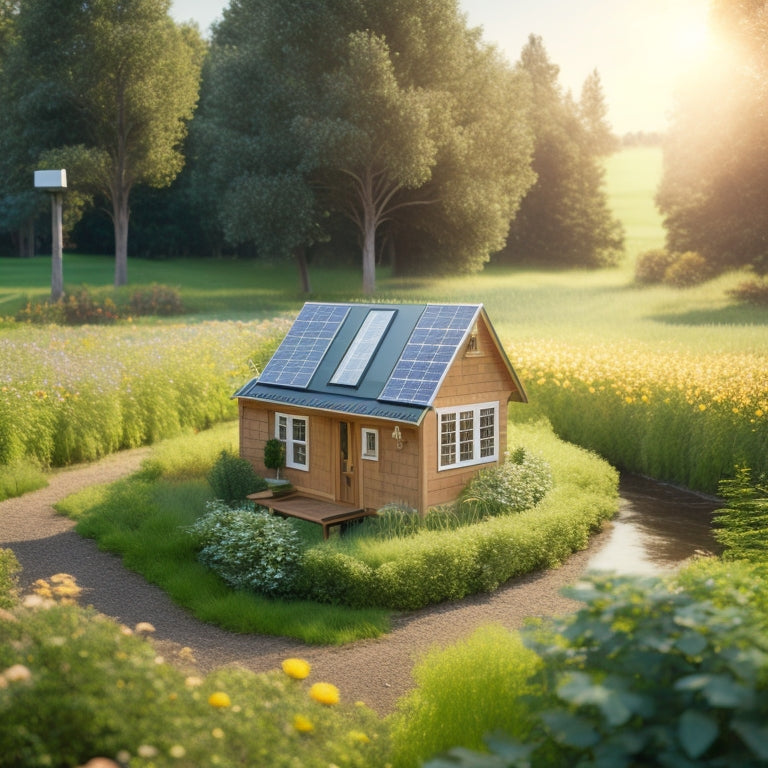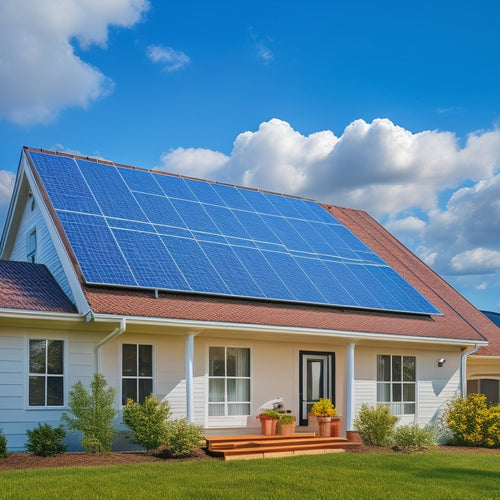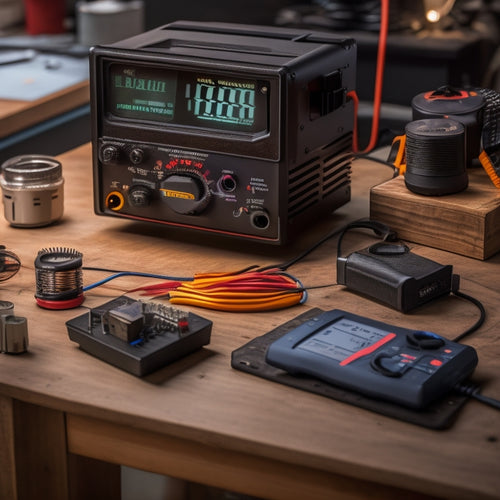
Tiny Home Energy Independence Made Easy
Share
You're likely seeking energy independence in your tiny home, and achieving it can be more straightforward than you think. Start by choosing the right DIY kit, considering components like solar panels, inverters, and mounting systems. Assess your energy needs by tracking consumption, listing appliances, and conducting an energy audit. Then, optimize your solar panel installation, select the right batteries, and guarantee proper safety precautions. By following these steps, you'll be well on your way to energy independence. Now, get ready to take the next step in designing and installing a reliable off-grid energy system that's customized to your tiny home's unique needs.
Overview
- Assess energy needs by tracking consumption and conducting an audit to identify areas for improvement and optimize energy efficiency.
- Choose high-quality components, including solar panels, inverters, and batteries, to ensure durability and reliability.
- Optimize solar panel installation by adjusting the angle seasonally and selecting high-efficiency panels with a minimum 25-year warranty.
- Implement energy-efficient appliances and practices, and consider lifestyle adjustments to reduce grid reliance and promote sustainability.
- Regularly monitor and maintain energy systems, including inspecting solar panels and checking battery health, to ensure peak performance and longevity.
Choosing the Right DIY Kit
When venturing into tiny home energy independence, one vital aspect is selecting the right DIY kit for your solar power system. You'll need to make informed kit comparisons to find the one that suits your needs.
Assess the quality of components, such as solar panels, inverters, and mounting systems. Reflect on the wattage and voltage ratings to guarantee compatibility with your tiny home's energy requirements.
It's also essential to reflect on the structural soundness of roofs and regular maintenance for successful installations. Additionally, energy efficiency and green financing options are available for budget-friendly solutions.
Budget considerations are also important, as DIY kits vary markedly in price. Set a realistic budget and balance it with the quality of the components.
Don't compromise on vital features, like durability and efficiency, to save a few dollars. By doing your research and making informed decisions, you'll be well on your way to achieving energy independence in your tiny home.
Assessing Your Energy Needs
Get down to business by mapping out your tiny home's energy requirements. Evaluating your energy needs is essential for achieving off-grid living.
Start by tracking your energy consumption to identify areas for improvement. To accurately calculate your daily energy needs, consider listing all appliances and devices to power, noting wattage ratings from manufacturer labels energy audit.
Conduct an energy audit to determine your peak usage periods and identify opportunities for conservation strategies. Consider lifestyle adjustments, such as reducing energy-intensive activities or switching to energy-efficient appliances with high efficiency ratings.
This will help you determine how much energy you'll need from renewable sources. By understanding your energy needs, you can develop a plan to reduce your grid reliance and shift to sustainable practices.
This evaluation will be the foundation of your path to energy independence.
Solar Panel Installation Tips
When installing solar panels on your tiny home, you'll want to guarantee you're maximizing energy production. This starts with optimizing panel angle, as even slight deviations from the ideal angle can greatly impact energy output.
To secure reliable energy production, it's crucial to select high-efficiency solar panels with a minimum 25-year warranty. You'll also want to evaluate the overall system size, including the number of solar panels, battery bank, and inverter capacity, to guarantee efficient energy supply.
You'll also need to assess battery backup essentials to store excess energy generated during the day for use during the night or on cloudy days.
Panel Angle Matters
Optimizing your solar panel installation involves more than just slapping panels on your roof - it's essential to take into account the angle at which they're positioned.
You want to maximize your solar exposure, so it's important to evaluate the best angle for your location. In the northern hemisphere, a tilt between 30-40 degrees is ideal, while in the southern hemisphere, it's best to tilt them towards the equator.
Don't forget to make seasonal adjustments to account for the changing sun's path. During winter, you'll want a steeper angle to capture more sunlight, and a shallower angle during summer to avoid overheating.
Battery Backup Essentials
Your tiny home's solar panel installation is only as dependable as its battery backup system. When it comes to energy storage, choosing the right battery type is essential.
You'll want to evaluate factors like depth of discharge, cycle life, and charging efficiency. Lead-acid batteries are a cost-effective option, but they're heavy and have limited lifespan.
Lithium-ion batteries, on the other hand, offer higher energy density and longer lifespan, but come at a higher cost.
You'll also need to assess the overall capacity of your battery bank, considering your daily energy needs and the size of your solar array.
Battery Selection and Safety
Selecting the right battery for your tiny home's energy independence is fundamental, as it will be the backbone of your off-grid system.
You'll want to take into account factors like depth of discharge, cycle life, and compatibility with your charging system. Deep cycle batteries, like lead-acid or lithium-ion, are ideal for off-grid systems.
When choosing a battery, verify it's designed for deep cycling and can handle the daily charge and discharge cycles. Proper battery maintenance is imperative, so make certain you understand the manufacturer's recommended maintenance schedule.
Safety precautions are also essential – always wear protective gear when handling batteries, and confirm they're installed in a well-ventilated area.
Inverters and Charge Controllers
You'll need to carefully select and size your inverter to guarantee it can handle your tiny home's power requirements, and that means understanding inverter sizing essentials.
Next, you'll choose a charge controller that's compatible with your battery type and recharging needs, which means familiarizing yourself with the different types available.
With the right inverter and charge controller in place, you can optimize their efficiency to get the most out of your tiny home's energy system.
Inverter Sizing Essentials
Sizing your inverter correctly is essential to guaranteeing a seamless flow of energy in your tiny home, as it directly impacts the overall performance of your off-grid system.
You'll want to take into account your power requirements, including the total wattage of your appliances and devices.
When selecting an inverter, you'll encounter different inverter types, such as modified sine wave, pure sine wave, and grid-tie inverters.
Research reputable inverter brands like Schneider, OutBack, and Magnum Energy to find the right fit for your system.
Be sure to oversize your inverter by 10-20% to account for unexpected power surges.
Accurate inverter sizing will confirm your system runs efficiently, providing you with the freedom and independence you desire in your tiny home.
Charge Controller Types
What determines the most efficient way to capture energy from your solar panels or wind turbines in your tiny home? The answer lies in the charge controller type you choose.
You have two primary options: Pulse Width Modulation (PWM) and Maximum Power Point Tracking (MPPT) charge controllers. PWM controllers are simple, cost-effective, and suitable for small systems. However, they can waste up to 20% of your generated energy.
MPPT controllers, on the other hand, optimize energy harvesting by constantly tracking the maximum power point of your solar panels or wind turbines, resulting in up to 30% more energy captured.
When it comes to maximizing your tiny home's energy independence, investing in an MPPT charge controller is a wise decision.
Efficiency Optimization Tips
Now that you've chosen the right charge controller for your tiny home's energy system, it's time to enhance its performance. To maximize your energy independence, you'll want to focus on efficiency enhancement.
Start by conducting energy audits to identify areas of energy loss. This will help you pinpoint opportunities for insulation upgrades, sealing air leaks, and improving your tiny home's overall energy efficiency.
When it comes to your inverter and charge controller, verify they're properly configured and calibrated for peak performance. Regularly monitor your system's performance and make adjustments as needed.
Monitoring and Maintaining Systems
Get set to plunge into the nitty-gritty of keeping your tiny home's energy systems running smoothly by tracking their performance and addressing any issues that arise.
You'll need a system monitoring setup to keep tabs on your energy production and consumption. This will help you identify areas for improvement and catch potential problems before they become major issues.
Create maintenance schedules for each system, including tasks like inspecting and cleaning solar panels, checking battery health, and performing routine software updates.
Frequently Asked Questions
Can I Connect My Tiny Home System to the Grid?
You can connect your tiny home system to the grid, but you'll need to maneuver energy regulations, ensuring your setup meets local standards; consider consulting an expert to facilitate a seamless grid connection that aligns with your off-grid aspirations.
How Do I Handle Energy Storage During Extended Cloudy Periods?
You're stuck in a cloudy abyss, watching your energy dreams fade like a vampire in sunlight. Don't worry, you're not doomed! Increase your battery capacity and optimize solar efficiency to guarantee a steady power flow, even when the sun's on a prolonged coffee break.
Are Tiny Home Energy Systems Suitable for Cold Climates?
You can adapt tiny home energy systems to cold climates by implementing advanced insulation techniques, like vacuum-sealed panels and thermal bridges, and incorporating efficient heating solutions, such as radiant floor heating and heat pumps, to maintain a comfortable temperature.
Can I Add a Wind Turbine to My Solar Energy System?
You can definitely add a wind turbine to your solar energy system, leveraging wind turbine benefits like increased energy production and reduced reliance on a single source. Hybrid systems like this guarantee a more consistent and reliable energy supply.
Do I Need a Building Permit for My Tiny Home Energy System?
As you begin your off-grid journey, you're wise to traverse the regulatory terrain; you'll need to research local building codes and permit requirements to guarantee your tiny home energy system complies, avoiding costly surprises down the road.
Ready to Buy
You've taken the first step towards tiny home energy independence. Now, imagine waking up in your off-grid cabin, powered entirely by your own DIY solar panel system. Take, for example, Sarah's 160-square-foot tiny home, which runs on a 2-kilowatt solar array, 4 deep-cycle batteries, and a 1,500-watt inverter. With her system, she saves $500 annually on energy bills and enjoys the freedom to roam, untethered from the grid. By following the steps outlined in this guide, you can achieve similar energy independence and start living off the land.
Related Posts
-

Cost of Solar Panel Installation
You can expect to pay between $15,000 and $30,000 or more for a typical solar panel installation, depending on the sy...
-

Top Camping Water Bottles for Adventure
When you're out adventuring, picking the right camping water bottle is essential for staying hydrated. Look for durab...
-

Key Features of a DC to AC Converter
A DC to AC converter features high efficiency and conversion rates, which reduce energy costs and improve performance...


